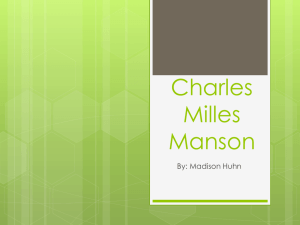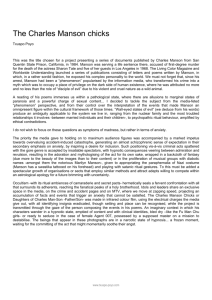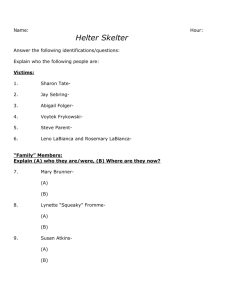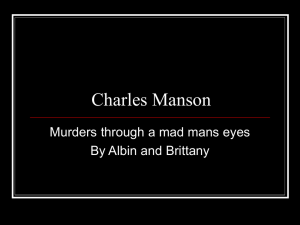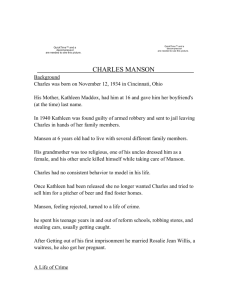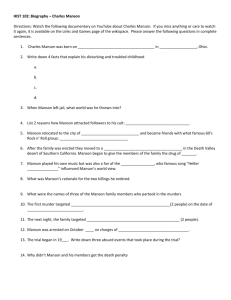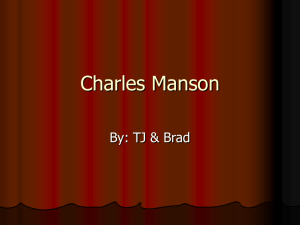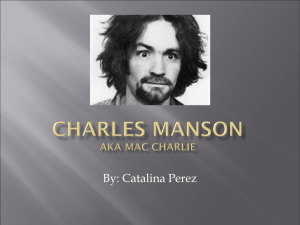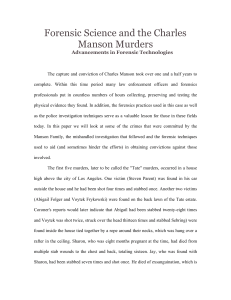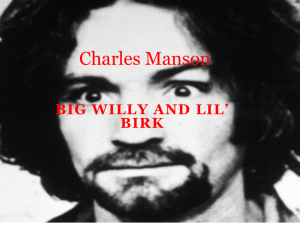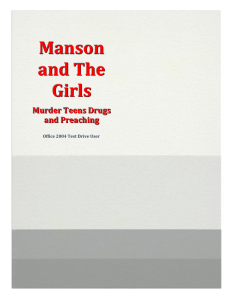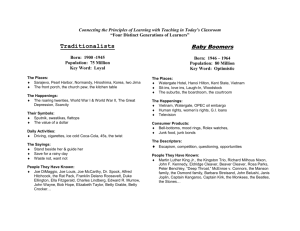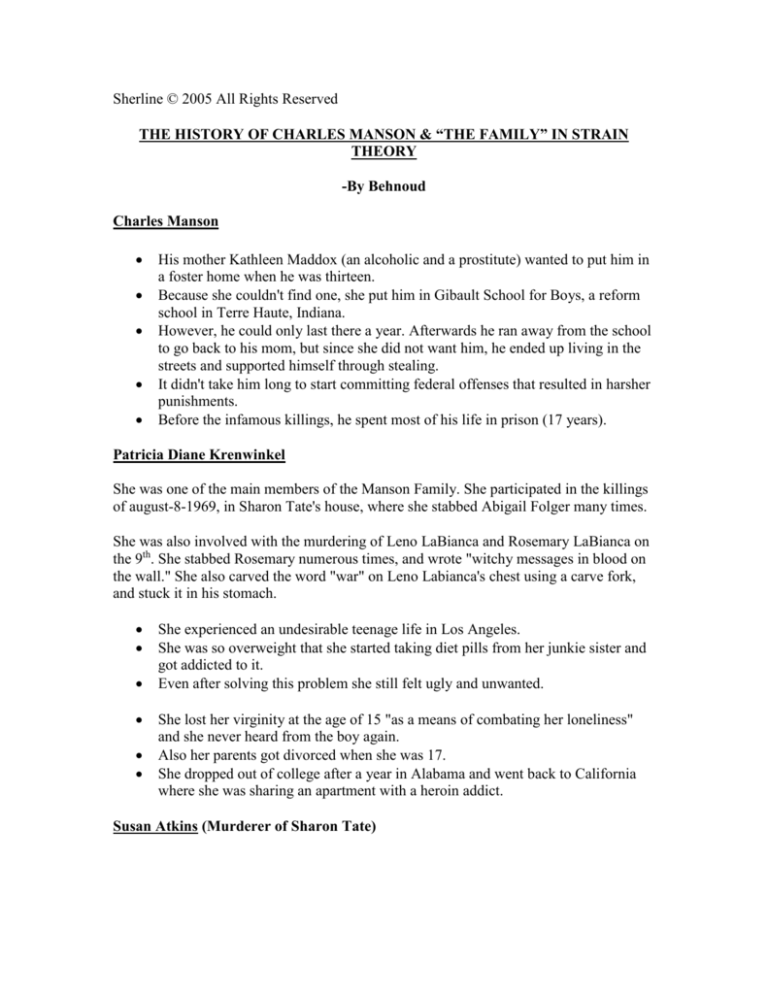
Sherline © 2005 All Rights Reserved
THE HISTORY OF CHARLES MANSON & “THE FAMILY” IN STRAIN
THEORY
-By Behnoud
Charles Manson
His mother Kathleen Maddox (an alcoholic and a prostitute) wanted to put him in
a foster home when he was thirteen.
Because she couldn't find one, she put him in Gibault School for Boys, a reform
school in Terre Haute, Indiana.
However, he could only last there a year. Afterwards he ran away from the school
to go back to his mom, but since she did not want him, he ended up living in the
streets and supported himself through stealing.
It didn't take him long to start committing federal offenses that resulted in harsher
punishments.
Before the infamous killings, he spent most of his life in prison (17 years).
Patricia Diane Krenwinkel
She was one of the main members of the Manson Family. She participated in the killings
of august-8-1969, in Sharon Tate's house, where she stabbed Abigail Folger many times.
She was also involved with the murdering of Leno LaBianca and Rosemary LaBianca on
the 9th. She stabbed Rosemary numerous times, and wrote "witchy messages in blood on
the wall." She also carved the word "war" on Leno Labianca's chest using a carve fork,
and stuck it in his stomach.
She experienced an undesirable teenage life in Los Angeles.
She was so overweight that she started taking diet pills from her junkie sister and
got addicted to it.
Even after solving this problem she still felt ugly and unwanted.
She lost her virginity at the age of 15 "as a means of combating her loneliness"
and she never heard from the boy again.
Also her parents got divorced when she was 17.
She dropped out of college after a year in Alabama and went back to California
where she was sharing an apartment with a heroin addict.
Susan Atkins (Murderer of Sharon Tate)
She was another member of the Manson family. She was involved in the mass murder of
Sharon Tate and others at her house. She stabbed Sharon Tate to death while she was
pregnant.
She grew up in an abusive house.
Both of her parents were alcoholics
She lost her mother at the age of 14 due to cancer.
Then her father sent both her and her younger brother to go and live with
relatives.
She dropped out of high school when she was 18 and moved to San Francisco and
she supported herself by topless dancing and selling drugs.
Leslie Van Houten
She was another member of the Manson Family. She was involved in the murdering of
the LaBiancas. However, she claimed that she only stabbed Rosemary after she was
already dead.
She was described by the prosecution as a spoiled child, who experienced a happy
childhood.
When she was 14, her parents divorced and as a result she started to take LSD.
She became pregnant at the age 15, however, she did not keep the baby and had
an abortion.
She joined the family through meeting with Bobby Beausoleil, a member of the Manson
Family.
Agnew's General Strain Theory
-By Behnoud
Strain theory has focused on the strain that causes an individual to commit crime.
(Agnew, 1992:49)
This theory claims that "negative treatment" from others causes anger and frustration,
which will lead an individual to commit crimes. (Agnew, 1997a:31)
Robert Agnew expanded this theory and included variables other than money, status
and lacking of legitimate and illegitimate opportunities that result in strain.
His general strain theory is based on the idea that "when people are treated badly they
may get upset and engage in crime" (Agnew, forthcoming).
Two types of strain introduced by him are "The loss of positively valued stimuli" and
"The presentation of negative stimuli".
The loss of positively valued stimuli:
It claims that the loss of positive stimuli can cause strain.
This loss can include death of a loved one, breaking a relationship with a
friend or a romantic partner, or could be the result of losing a valued object.
The presentation of negative stimuli:
Some examples of negative stimuli are child abuse, neglect, harmful
relationships with parents and teachers, negative school experience, harmful
relationships with peers, neighborhood problems and homelessness. (Agnew,
1992:58-59).
Basically, Agnew's general strain theory suggested that an increase in strain would result
in an increase in anger, which would then result in individuals to commit crimes.
(Agnew, 1992:61).
This theory heavily applied to all the members of “The Family”
Emile Durkheim Strain theory
-By Mike
Emile Durkheim’s functional theory of crime has four ideas central to its understanding.
Using these ideas one can examine the Tate/La Bianca case through a strain perspective
and offer an explanation as to why the crime was committed.
1. The first point is that human beings are essentially egoistic and their wants exceed
their means available to satisfy them (35).
- Charles Manson’s theory of “Helter Skelter” was egoistic his theory
entailed an ‘ultimate race war’.
-He did not have the means of carry out this theory so he initiated the
murder of Sharon Tate to help ignite this war.
2. The second idea is that social order is based on shared values and norms (35).
-Charles Manson did not have the same shared values and norms of race
and killing. Therefore he disturbed the social order by killing seven people
and the murdering a pregnant woman who also was a movie star
-This act went against all shared values and norms in society.
3. The next idea is that regular recurring activities continue to exist because they
contribute to stability (35).
-In this case crime was considered ‘good’ because it contributed to
stability, in other words, it showed people what was right and what was
wrong.
4. Lastly, society is considered an organism that is made up of interdependent parts
in equilibrium (35).
-This crime is seen as a part of society that helps it maintain equilibrium.
Durkhiem’s Anomie theory is another characterization of Manson’s crime. Anomie, in
Rules, is associated with social change and refers to the economy, an anomic economy
increases egoistic behavior because it frees a person from moral regulation and in turn the
person is in a state of war.
In 1969 the Vietnam War was being fought as well as the ongoing cold war
(http://en.wikipedia.org/wiki/ 1969). The Vietnam War caused many protests and could
therefore, be seen as a time of crisis, which led to increased egoism and weakened shared
values and norms. Therefore, the weakening of shared values and norms affected Charles
Manson and are reflected in his theory of “Helter Skelter”.
Cloward and Ohlin’s Strain Theory
-By Keisha
Cloward and Ohlin’s differential opportunity theory relates to the issues found within the
life style of Charles Milles Manson throughout his childhood.
Charles Manson’s Life story
Charles Manson’s mother was a prostitute that did not provide him love and
placed him in a foster home.
Charles Manson runaway from the foster home, turned to the street and start to
indulge in what Cloward and Ohlin would call illegitimate opportunities such as
theft in general, stolen cars, solicitation of prostitution, and forgery of federal
checks because he do not have the skills required to achieve legitimate goals.
He strove for status through his involvement in a gang subculture called “The Family”.
Manson had been in and out of penitentiaries throughout his life, which caused
him to resort to antisocial behavior.
Moreover, after his release in 1967, Charles Manson formed a group called “The
Family” which neglected all of the conventional morals of the western world.
This is a prime example of Cloward and Ohlin’s theory of conflict subcultures as
a type of gang that uses violence, which predominates as a way of winning status.
Manson’s gang called “The Family” committed murders as a means of gaining
head status for ruling the world.
Charles influenced others to believe in his doctrine and would kill white people
and try pin it on black people.
Through “The Family”, Charles finally achieved master status and convinced his
followers that he was Jesus.
Cloward and Ohlin would say that Manson achieved his master status through
illegitimate means that he could not obtain through legitimate means.
Sherline © 2005 All Rights Reserved

